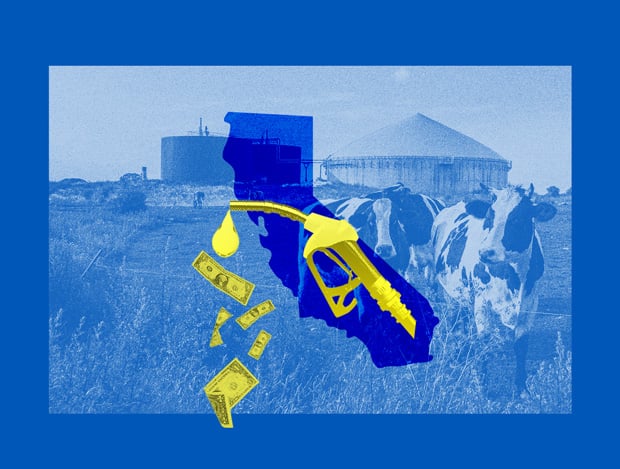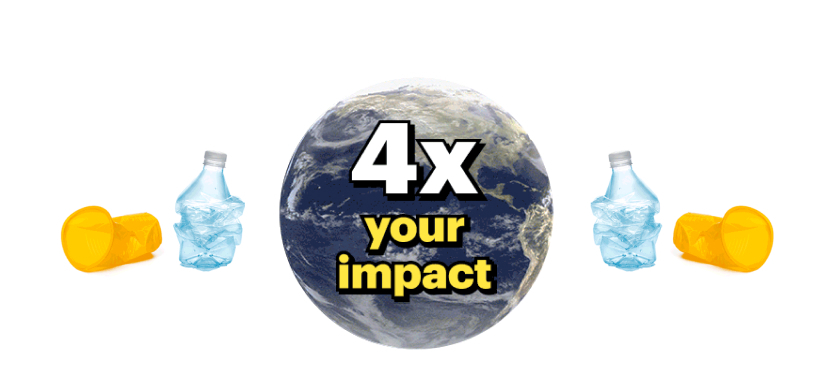How California Subsidizes Factory Farm Pollution Nationwide
Published Feb 7, 2024

California’s Low Carbon Fuel Standard boosts dirty energy, factory farms, and more environmental injustice. Now, we have an opportunity to change that.
California is known for many things — national forests and sunny beaches, Hollywood and Silicon Valley. Less famous are its dairy cows; 1.7 million of them, who are largely raised on factory farm mega-dairies. The state has more mega-dairies than any other, and they are largely concentrated in Central Valley communities.
The result of this massive and highly concentrated industry? Enormous amounts of waste, pollution, and climate emissions spewed into communities already facing some of the most polluted air and water in the country.
A growing industry claims to lower mega-dairies’ harmful impact by turning that waste into fuel. It’s been greenwashed as “biogas” or “renewable natural gas,” but we’ll call it like it is: dirty factory farm gas.
California has supported the expansion of factory farm gas with hundreds of millions of dollars in subsidies, notably through its Low Carbon Fuel Standard (LCFS). But this does way more harm than good. It entrenches dirty energy, polluting factory farms, and environmental injustice not just throughout the state, but throughout the entire country. Projects nationwide can and do profit from LCFS credits.
This year, the California Air Resources Board (CARB) proposed new rules for the LCFS that would continue paying factory farms to pollute for decades to come. We can’t allow this to happen — CARB and Governor Gavin Newsom must reverse course. We’re calling on them to end the LCFS’s lavish support for this dirty gas once and for all.
The Factory Farm Biogas Boondoggle Is Bad News for the Climate
Corporations have touted gas made from factory farm waste as a new “renewable” or even “clean” energy source. But it has similar downsides to fossil gas and entrenches the already harmful factory farm system.
Factory farm gas starts with open cesspools — what the industry calls “lagoons” — which factory farms commonly use to store animal manure. Companies then process that manure in digesters, extracting gasses that can be refined into fuel. The process also creates digestate, the solids left behind by the process.
Turning this gas into energy comes with many of the same problems as burning fossil gas. It emits harmful air pollution and leaks methane, a potent greenhouse gas, throughout the supply chain. In fact, if factory farm gas takes the place of real renewables like solar and wind, it actually increases climate emissions.
The factory farm gas industry is expanding these harms throughout the country. And government subsidies, including those from the LCFS, are driving the industry’s growth.
The Low Carbon Fuel Standard: Bad Math Leads to Bad Outcomes
The LCFS aims to reduce the climate impact of California’s transportation by allowing companies to trade pollution credits on a market. It assigns fuels different “carbon intensity” ratings, which are supposed to represent their impact on the climate.
So how does it work? Let’s look at an example.
Under the LCFS, factory farm gas has a negative carbon intensity. A factory farm can sell its gas as fuel — but most of the revenue comes from the LCFS credits earned by “capturing” the gas. The factory farm can sell these credits to, say, a diesel company. Because diesel has a high-carbon intensity rating, under state law, the company must either sell less diesel or buy a certain number of credits to “offset” its emissions.
But the way CARB calculates carbon intensity — its “life cycle assessment” — for factory farm gas doesn’t consider the emissions from factory farming animals in the first place. Factory farms’ methane emissions problem comes from confining massive numbers of animals and storing their manure in cesspools — pasture-based livestock don’t have this manure methane problem.
CARB also ignores how these facilities leak a lot of methane even after installing a digester. Moreover, it ignores how the handling and disposal of digestate emits more climate-warming nitrous oxide and methane than undigested waste.
In other words, CARB ignores both the up- and downstream emissions of factory farm gas production. As a result, factory farm gas gets a ridiculously low carbon intensity rating — far lower than even solar and wind. This creates huge subsidies to factory farm gas through the credits that producers receive and sell.
Notably, these calculations include so-called “avoided methane crediting.” The idea is that capturing methane from cesspools keeps it out of the atmosphere. However, the industry could prevent methane emissions by simply using greener waste management practices or by stopping factory farming altogether.
While Big Oil and Big Ag Profit, Frontline Communities Lose Out — Again
Big Oil and Big Ag are throwing their weight behind factory farm gas. Oil and gas giants Chevron and BP and meat giant Smithfield know that investing in digesters will deliver hefty, government-funded returns. California’s programs, including the LCFS, are the main source of revenue for dairy digester projects in the state and pour cash into factory farms across the country.
At the same time, these corporations can greenwash their images by touting their support for “clean” energy, creating a cover for their continued pollution and damage to the climate.
While polluters win, communities lose. The LCFS entrenches and worsens the many harms that factory farms inflict on neighboring communities. Factory farms are huge sources of air and water pollution. They devastate public health and local economies.
In California, as in many states, these harms disproportionately impact low-income communities and communities of color. For example, the Central Valley is home to most of the state’s factory-farmed dairy cows. This lower-income region also has the highest rates of emergency room visits for children with asthma. Digesters do nothing to reduce these harms — in fact, they may worsen some of them, like ammonia pollution.
CARB claims that its new rules “uplift environmental justice,” but they disregard the voices of fence line communities, and they ignore the central, foundational injustice behind factory farm gas — factory farms.
Changing the LCFS and Saying “No” to Factory Farm Gas
Ultimately, the LCFS drives more cesspools, methane generation, and polluting factory farms across the country. We’re already seeing projects built in 12 states, including those as far-flung as Wisconsin and New York. California is exporting its dirty energy policy to rural communities throughout the U.S. without regard for the local impacts. It’s literally paying corporations to pollute our air, water, and climate nationwide.
This month, CARB is gathering public comments on its proposed rules. We’re seizing the opportunity to make our demands heard. We need reforms to the LCFS that treat factory farm gas as it really is — dirty energy that hurts our climate and communities. Governor Newsom and CARB must put people before corporations cashing in on pollution.
We need your voice. Tell Governor Newsom and CARB to reform the LCFS and end support for dirty factory farm gas!

Time to face it —~it’s people or plastics.~We can’t have both.
Become a plastic pollution fighter this Earth~ Day and have your gift MATCHED $3-to-$1!
Enjoyed this article?
Sign up for updates.
TO TOP


